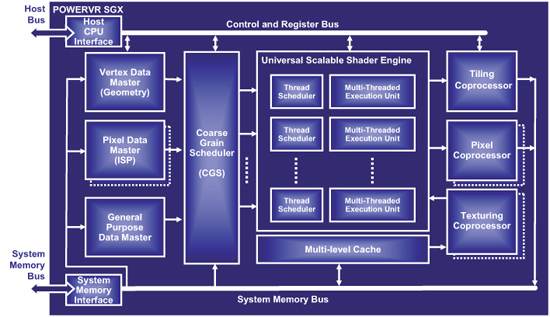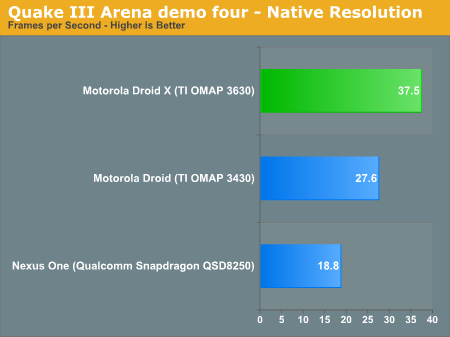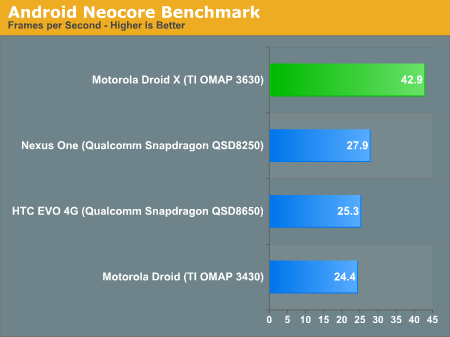Motorola Droid X: Thoroughly Reviewed
by Brian Klug on July 20, 2010 4:27 PM EST- Posted in
- Smartphones
- Motorola Droid X
- OMAP
- Mobile
The OMAP GPU - Powered by Imagination Technologies
TI continues to license its GPUs from Imagination Technologies. Rather than move to the PowerVR SGX 535 used by Apple and Intel, TI stuck with the same PowerVR SGX 530 core used in the OMAP 3430. The difference between the SGX 530 and 535 is as follows.
ImgTec refers to the execution hardware in its Series 5 GPUs as a Universal Scalable Shader Engine (USSE). Each USSE pipe can execute a 2-wide vector or up to a 4-way SIMD scalar op in a single clock. Both the SGX 530 and 535 have two USSE pipes from what I can tell.

The SGX 535 used in Apple’s A4 and Intel’s Atom Z600 series apparently have a second texturing unit and DirectX 9L support.
We’d expect that 3D apps on smartphones are more compute bound these days so it’s difficult to say how much you lose by going with the SGX 530 vs. 535. Until we get a Moorestown dev kit running Android we won’t be able to shed much light on that.
While the OMAP 3430 ran the GPU core at ~110MHz, the 3630 ramps it up to 200MHz. We’re seeing a lot of convergence around this 200MHz mark at 45nm. Intel runs the SGX 535 in Moorestown (Atom Z600 series) at 200MHz as well and I believe that’s what Apple uses in the A4 as well.
The 80% increase in GPU clock speed should result in significant real world GPU performance improvements. Just as with the CPU, there are no significant architectural changes to the GPU - it just runs faster.
The memory controller is still a 32-bit LPDDR1 interface, but can now run at up to 200MHz (the 3430 was limited to 166MHz). Should a customer choose to go for 200MHz LPDDR1 you’d get a 20% increase in memory bandwidth which will come in handy with the faster GPU in 3D apps for sure.
The GPU Performance Showdown: Snapdragon vs. OMAP 3630
When Brian first started cranking on the Droid X review he wanted to put the Qualcomm Adreno 200 vs. PowerVR SGX debate to rest. We had always reported that Qualcomm’s Snapdragon GPU was slower than the PowerVR SGX used in Apple’s A4 and TI’s OMAP 3, but we didn’t have a good idea of how much slower. Until now that is.
Armed with the Google Nexus One (Snapdragon QSD8250), Motorola Droid (OMAP 3430) and Motorola Droid X (OMAP 3630) all running Android 2.x (the N1 was running 2.2) we polished off one of the most popular GPU benchmarks of our time: Quake III Arena.
The kwaak3 project ported Q3A from a Nokia N900 version to Android. With a bit of elbow grease and getting around the lack of touchscreen keyboard support, we got the benchmark running. All scores were generated at default graphics quality settings and at native resolution, which unfortunately means the Droid X has around 7% more pixels to render than the other Android devices.

Even with the handicap, the 200MHz PowerVR SGX 530 core manages double the frame rate of the Adreno 200 in the Nexus One’s Snapdragon. Even the 110MHz SGX 530 is faster.
Here’s another interesting tidbit - we’re actually CPU bound on all of these platforms running demo four in Q3A:

Droid X (OMAP 3630) CPU utilization while running Quake III Arena
Intel is talking about greater than 100 fps frame rates with Atom Z600, meaning that the advantage is strictly on the CPU side. This also tells us that the PowerVR SGX 530 may even be a good fit for next year’s Cortex A9 based SoCs, even though TI has already committed to using the SGX 540 in its OMAP 4 line.
Neocore is another popular GPU benchmark, although this one is written for Qualcomm’s Adreno 200. The OpenGL ES 1.1 benchmark is mostly a GPU test but also stresses the platform as a whole. Running on our OMAP 3 based phones we see an average of 50% CPU utilization during the test.

The Droid X (OMAP 3630) CPU utilization while running Neocore
Interestingly enough, running the same test on a Snapdragon platform shows higher CPU utilization:

The Nexus One (Snapdragon) CPU utilization while running Neocore
The benchmark could be very well optimized for Qualcomm’s Scorpion core resulting in better CPU utilization compared to a Cortex A8.

The Adreno 200 in the Nexus One and EVO 4G outperforms the PowerVR SGX in the original Droid by 4 - 14%. This isn’t a surprise given the Qualcomm branding on the benchmark. The 45nm SGX 530 running at 200MHz puts all question to rest, the OMAP 3630 is 53% faster than Snapdragon.
The comparison here is obviously more than just GPU to GPU. We’re dealing with different CPU cores (ARM Cortex A8 vs. Qualcomm Scorpion), different memory controllers, different caches, and different drivers. Just as we’ve seen in the desktop GPU race, driver and benchmark optimizations have a lot to do with 3D performance results. I put more faith in the Quake 3 results, however those too came from a port optimized for PowerVR’s SGX.










89 Comments
View All Comments
Swift2001 - Saturday, July 24, 2010 - link
I'm not stuck with that ridiculous red blob on the front page, am I? Don't know about you, but I don't want to turn my eye into a bloodshot beast's eye.GEverest - Sunday, July 25, 2010 - link
Is there some way to attach the Droid X to a tripod or something equivalent? I sing in a quartet and we often want to take a video of us singing to review how we look and hence improve.GEverest - Sunday, July 25, 2010 - link
Will it be possible to upgrade from 2.1 to 2.2 (Froyo) and eventually to 3.0? I presume it is a software upgrade.strikeback03 - Tuesday, July 27, 2010 - link
Motorola has promised it will see 2.2 later this year. 3.0 is unknown, but probably a batter than even chance. If whatever security they use is circumvented and custom ROMs can be flashed then you will probably be able to run whatever you want.lukeevanssi - Sunday, July 25, 2010 - link
it is possible but not in the moment.the droid is like a iphone
iphone took about 3 months to unlock and another 2 months for the internet to work on tmobile.
the droid took 2 months to find a flash to metropcs (which has been found).
the code for the internet and mms for flashed metropcs droid has not yet been found or solve.
http://choyungteatrial.org
markomd - Sunday, July 25, 2010 - link
It really is a lovely little machine but it won't integrate vertically with my all-Mac system. Too bad it doesn't run on OS 4.1 or I'd buy one in a heartbeat. Alas, I must wait until Steve and company fix iPhone 4 and make nice with Verizon.silverwarloc - Monday, July 26, 2010 - link
Great review btw...but, I wanted to know the problems that have been posted on youtube concerning the screen flicker. Is this rampant? Or isolated?Brian Klug - Monday, July 26, 2010 - link
I haven't seen any screen flicker on mine, even almost a month later. I'm guessing it was just a bad batch of displays. I haven't had any of the display issues I've seen floating around. I should have made note of that, but if it was broken I would've definitely called it out.-Brian
crunc - Monday, July 26, 2010 - link
I got to know anandtech from their iPhone 4 review, which put all others to shame, and here again they've done a bangup job. The thought and detail put into these reviews is just amazing.halcyon - Tuesday, July 27, 2010 - link
Could you please compare to Samsung Galaxy S variants as well?It spanks these babies (sans iPhone 4) on almost everything, afaik, battery, screen, cpu/gpu...
It'd be interesting for comparison purposes.
Also, Galaxy S is available almost everywhere in the world, Droid X has very miniscule availability in some parts of the US only.